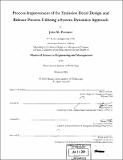Process improvement of the emission decal design and release process utilizing a system dynamics approach
Author(s)
Pommer, John M. (John Matthew), 1969-
DownloadFull printable version (12.50Mb)
Other Contributors
System Design and Management Program.
Advisor
James M. Lyneis.
Terms of use
Metadata
Show full item recordAbstract
In the past ten years, automobile manufacturers have spent a growing amount of money on recall campaigns and late fixes brought about by emission decal problems, due in part because engineers and management do not fully appreciate the dynamic complexity of the emission decal design and release process. In particular, because the decals are technically simple, people incorrectly assume that the informational and process complexity is also simple. As a result, practices and policies for managing the entire decal design, release, and installation processes inevitably lead to difficulties. Poor systems understanding has ultimately resulted in increased recall campaign costs. Using many of the key tools taught as part of the Massachusetts Institute of Technology's System Design and Management (SDM) curriculum, I will endeavour to briefly describe the relevant details of the complicated emission certification and emission decal design processes and their inherent difficulties. An overview of the process is required to better see where the system often breaks down, and to better use the tools taught in the SDM curriculum to suggest where changes might be appropriate to reduce difficulties and warranty costs. Using these tools, I will build a case to support my hypothesis that the misunderstood complexity of the emission decal design and release process drives errors, and suggest remedies to help alleviate the problems. Much of this thesis focuses on the certification and emission decal design and release efforts of Ford Motor Company (Ford) and General Motors (GM). Many of the leading edge emission efforts are focused in the United States, so although efforts for overseas markets are briefly described, the primary focus is of this paper is on the system used by Ford and GM to meet requirements in the North American market.
Description
Thesis (S.M.)--Massachusetts Institute of Technology, System Design & Management Program, 2004. Includes bibliographical references (p. 122-123).
Date issued
2004Department
System Design and Management Program.Publisher
Massachusetts Institute of Technology
Keywords
System Design and Management Program.